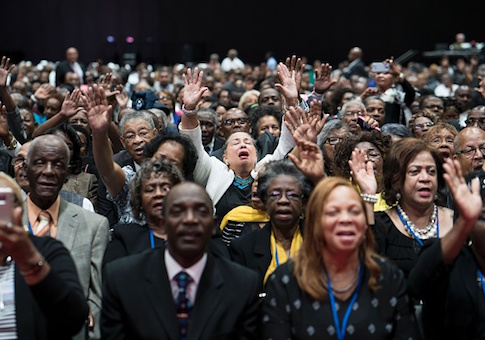Participation in institutions such as the U.S. military, churches, and marriage are all strongly related to black men's chances of reaching the middle class, according to a new report released Tuesday by the American Enterprise Institute.
"Black Men Making It in America: The Engines of Economic Success for Black Men in America" explores the effects which help African American men avoid poverty and achieve or preserve a middle-class life. That group has increased in size over the past 50 years, the report notes—57 percent of black men were in the middle or upper-third income brackets in 2016, compared to 38 percent in 1960. By comparison, the proportions for white, Asian, and Hispanic men remained roughly constant over the same period of time.
This precipitous and unique rise provides context to what the report describes as the "sobering, if not downright depressing" news about black men in America over the past decade. Emphasizing the "good news" can help "correct negative depictions and predictions regarding black men," study author and AEI visiting scholar Bradford Wilcox said Tuesday morning. At the same time, disentangling the underlying drivers of this growth can be helpful in better targeting policy to help the nearly half of the black male population that remains in the lowest third of the income distribution.
So what has helped black men reach the middle class? To answer this question, authors Wilcox, Wendy Wang, and Ronald Mincy looked at data from the National Longitudinal Survey of Youth (1979 wave). NLSY79 is a nationally representative study of Americans who were ages 14 to 22 in 1979, tracking how their lives have changed through today. Mincy et al. looked specifically at the approximately 850 black men included in NLSY79, considering how different factors affected whether or not they were in the top two-thirds of the income distribution in their 30s or 50s.
In their teens/early twenties, this cohort was not doing so well—67 percent were in the lowest third of the income distribution, compared to 22 percent of their white peers. But, in line with the national trend, the group fared better over time. By their 30s the black cohort was only 44 percent in the bottom third; by their 50s, they were 52 percent in the bottom third, a decline but still better than their childhoods.
Those black men who reached the upper two-thirds of the income distribution were different from their less-successful peers in a number of ways. Middle class black men were more likely to have graduated from college, be working full time, and be married. As young people, they were more likely to have attended church or enrolled in the military than their lower-class peers. And, according to a standard test administered by the study's authors, they had a higher sense of "agency" over themselves and the world around them.
Interestingly, the study did not find a connection between family structure in childhood and wealth later in life. Wilcox told the Washington Free Beacon that he wasn't sure why this was, given that previous work by him has emphasized the importance of family structure for the well-being of black boys.
"Family structure of origin was not related to black men's success in the NLSY79. That was a surprise," Wilcox said. "But family structure mattered a lot as men went forward in life. So black men who married did much better than their peers who did not. Black men benefit, financially, from the fact that black women are in the labor force at high rates."
While family structure did not seem to have much of an impact, another variable proved a major roadblock to black men's success: interaction with the criminal justice system. The study estimates that contact with the criminal justice system more than doubles the probability that a given black man will be poor in his fifties (this effect is moderated by work and marital status, based on a statistical analysis).
These effects may of course just be correlations, so the study's authors also compared them using multivariate regression. Using a series of models containing measures of education, work status, marital status, religious attendance, military service, and criminal history, they found that they still had strong impact. Attending religious services regularly, being charged with a crime, military service, an associate or bachelor's degree, and marriage remained strongly correlated even controlling for other factors.
The study's goal, Mincy noted, was not to deemphasize the real problems that black men face in America today.
"Our report is not meant to diminish some of the real threats that are occurring in communities of color, particularly the mass incarceration and victimization by the police," he said on Tuesday.
Rather, Mincy, Wang, and Wilcox concluded with a set of policy proposals to help the 48 percent of black men still in the bottom third. Expanding early education programs, increasing access to college, and reducing overincarceration were all major priorities. But so too were more socially-oriented interventions like extending lessons from the well-integrated military, eliminating marriage penalties in welfare programs and encouraging marriage, and enabling the black church to have greater social power.
Lastly, the study's authors were careful to emphasize how the measure of agency played what they saw as an important role.
"As this report shows, young black men who believe they are captains of their own lives are more likely to do well as they reach midlife," they conclude.
